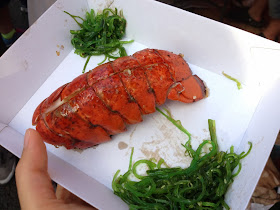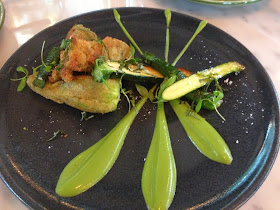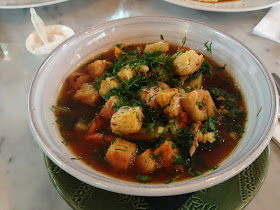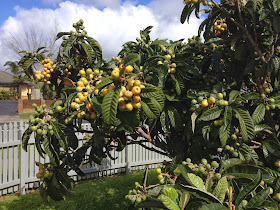 |
| Loquats on the tree. |
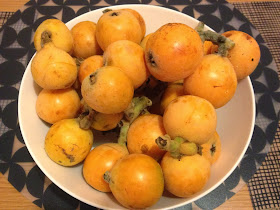 |
| Ripe loquats. |
 |
| Inside a loquat. |
 |
| Loquat halves laid out for drying. |
Sadly, that was a waste both of effort and delicious fruit, as even days later, the pieces were still not dry (perhaps I should have turned the oven on for longer). Pricking the skins with a fork and turning some of the pieces over did not help much either. Not only that, the orange rounds had oxidised and turned black, and the beautiful fragrance of the fresh fruit was no longer there.
 |
| Unattractive partially-dried loquats. |
All those loquats left me with something else on my hands. I did not want to simply throw the seeds away, and when I discovered that people made loquat liqueur with them, I decided to give it a go as well. I haven't had success with brewing in the past, but loquat liquer didn't require any skills or special equipment. This was really only going to be a vodka infusion.
 |
| Loquat seeds. |
While searching for recipes, I came across some pretty scary sounding advice out there. For instance, a post by bpotter on the GardenWeb forum claimed the seeds contain a dangerous level of cyanide compounds:
Most of the stone fruit (peaches, apricots, plums) are in the rose family and loquats (at least 2 different species I know of) are members. Their pits contain dangerous levels of cyanide compounds. Our native holly-leaf cherry was used by the native Chumash people as a source of food and they knew that they had to leach out the poisons from the pits by repeated soakings and boilings before they made a mush out of them.Others, such as Susan Lutz at Zester Daily, point out that while the pits contain toxic substances, there is not enough to worry about:
I put in a call to professor Jules Janick, director of the Indiana Center for New Crops and Plant Products at Purdue University. He’s not only the co-editor of “The Encyclopedia of Fruits and Nuts,” he is also a kind and understanding voice of reason. Janick told me that loquat seeds are indeed toxic, but then so are the seeds of apples and pears. To put things into perspective, Janick said, “If you ate 3 pounds of them, then it might be a problem.” He also reminded me that the bitterness of the seeds would stop someone from eating them pretty quickly. I realized that my daughter was at far greater risk for choking on a loquat seed than being poisoned by its chemical components.Then there are those who deliberately eat the seeds out of the belief that it can help combat cancer. A modified form of the chemical amygdalin found in the pips (also in the kernels of apricots, peaches, cherries, and almonds) is marketed as Laetrile, although there is no proof that it is effective against cancer.
I wasn't able to find out how dangerous loquat seeds were, but I did come across some tables for other foods. This came with the warning that "cyanogen levels can vary widely with cultivar, climatic conditions, plant part and degree of processing."
| Plant | Cyanogen content (mg HCN/kg) | Major cyanogenic glycoside present |
|---|---|---|
| Giant taro (Alocasia macrorrhizos) – leaves | 29-32 | Triglochinin |
| Nectarine (Prunus persica var nucipersica) – kernel | 196-209 | Amygdalin |
| Flax (Linum usitatissimum) – seed meal | 360-390 | Linamarin, linustatin, neolinustatin |
| Peach (Prunus persica) – kernel | 710-720 | Amygdalin |
| Plum (Prunus spp.) – kernel | 696-764 | Amygdalin |
| Apple (Malus spp.) – seed | 690-790 | Amygdalin |
| Apricot (Prunus armeniace) – kernel | 785-813 | Amygdalin |
| Cassava (Manihot esculenta) – root | 15-1000 | Linamarin |
| Sorghum (Sorghum vulgare) – leaves | 750-790 | Dhurrin |
| Whole Sorghum | 2500 | Dhurrin |
| Lima beans (Phaseolus lunatus) | 100-3120 | Linamarin |
| Bitter almonds (Prunus dulcis) | 2500-4700 | Amygdalin |
| Bamboo (Bambusa arundinacea) – young shoots | 100-8000 | Taxiphyllin |
The numbers above don't entirely agree with a New York Times Q&A piece, which quotes Dr. Margaret Dietert, associate professor of biology at Wells College, Aurora, N.Y., in saying that "13 to 15 raw peach pit kernels would get you into the lethal range for adults", while the level of cyanogen in apple seeds is "about a quarter as much as peach pits for the same weight".
Meanwhile, food scientist consultant John Fry has this to say in The Naked Scientists, again about apple pips:
You need about 1 milligram of cyanide per kilo of body weight to kill a human being. Apple seeds contain about 700 milligrams of cyanide per kilo, so about 100 grams of apple seeds should be enough to dispatch a 70-kg adult human, but that’s an awful lot of apple cores even if you don't eat the rest of the apple first. In addition, the seeds would have to be pretty finely crushed to let the enzymes get to the amygdalin at all. All in all, you're safe eating the occasional apple core. I've done it for years. Just don't try eating a bowl of freshly crushed apple pips.I still had some reservations about eating anything made with loquat seeds, but seeing that people even use the roasted seeds as a coffee substitute helped to allay those fears.
Making Loquat Liqueur
Although loquats come from China, they are also common in other countries such as Italy, where they are called nespoli. A liqueur made from the loquat seeds is called nespolino, similar to nocino made from unripe green walnuts, and amaretto made from apricot kernels or almonds.
I roughly followed the directions from Gardenista, which went like this:
Rinse seeds and set out in the sun to dry for two weeks.I'm not sure why the seeds should be set out in the sun to dry. Another recipe for loquat grappa omits this step. Perhaps it helps to intensify the flavour?
The classic Italian recipe calls for grain alcohol, but a neutral vodka works as well. To the pits, add one whole vanilla bean and 1/4 of a lemon rind, pith removed. Let this sit in the sun for about a month. Add a sugar simple syrup to taste, and then let it sit for another two weeks.
 |
| Loquat seeds with lemon peel in vodka. |
After a couple of weeks of soaking, I noticed that the liquid level had dropped in my jar. Did the alcohol evaporate away somehow, or did it get absorbed into the seeds? I topped up with more vodka, and noticed a delicious almond and floral fragrance already.
 |
| Reduced level of liquid. |
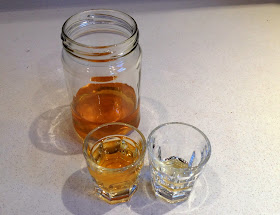 |
| Fragrant end product. |
This post is part of Our Growing Edge, a monthly blogging event aimed at inspiring us to try new things. This month, it is hosted by Kindra, from California Cavegirl Kindra.






